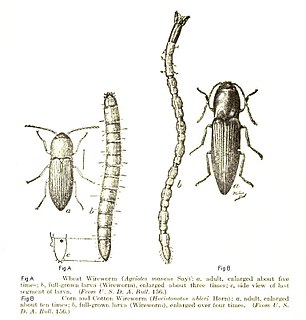
Stag beetles is a family of about 1,200 species of beetles in the family Lucanidae, currently classified in four subfamilies. Some species grow to over 12 centimetres, but most to about 5 cm (2 in).

The Curculionidae are the family of the "true" weevils. They are one of the largest animal families, with 6,800 genera and 83,000 species described worldwide. They are the sister group to the subfamily Brentidae

Elateridae or click beetles are family of beetles. Other names include elaters, snapping beetles, spring beetles or skipjacks. This family was defined by William Elford Leach (1790–1836) in 1815. They are a cosmopolitan beetle family characterized by the unusual click mechanism they possess. There are a few other families of Elateroidea in which a few members have the same mechanism, but most elaterid subfamilies can click. A spine on the prosternum can be snapped into a corresponding notch on the mesosternum, producing a violent "click" that can bounce the beetle into the air. Clicking is mainly used to avoid predation, although it is also useful when the beetle is on its back and needs to right itself. There are about 9300 known species worldwide, and 965 valid species in North America.
The false stag beetles (Diphyllostoma) are a group of three species of rare beetles known only from California. Almost nothing is known of their life history beyond that the adults are diurnal and females are flightless; larvae have not been observed.

Histeridae is a family of beetles commonly known as clown beetles or Hister beetles. This very diverse group of beetles contains 3,900 species found worldwide. They can be easily identified by their shortened elytra that leaves two of the seven tergites exposed, and their elbowed antennae with clubbed ends. These predatory feeders are most active at night and will fake death if they feel threatened. This family of beetles will occupy almost any kind of niche throughout the world. Hister beetles have proved useful during forensic investigations to help in time of death estimation. Also, certain species are used in the control of livestock pests that infest dung and to control houseflies. Because they are predacious and will even eat other Hister beetles, they must be isolated when collected.

Staphyliniformia is a large infraorder of beetles. It contains over 70,000 described species from all regions of the world. Most species occur in moist habitats - various kinds of rotting plant debris, fungi, dung, carrion, many live in fresh water.
Texas kangaroo rat seen in Carter County, Oklahoma, 9-20-2020, J. P. Greeley | name = Texas kangaroo rat | status = VU | status_system = IUCN3.1 | status_ref = | genus = Dipodomys | species = elator | authority = Merriam, 1894 }}
An elater is a cell that is hygroscopic, and therefore will change shape in response to changes in moisture in the environment. Elaters come in a variety of forms, but are always associated with plant spores. In many plants that do not have seeds, they function in dispersing the spores to a new location. Mosses do not have elaters, but peristomes which change shape with changes in humidity or moisture to allow for a gradual release of spores.
Conus abruptus is an extinct species of sea snail, a marine gastropod mollusk in the family Conidae, the cone snails and their allies.
In the 10th edition of Systema Naturae, Carl Linnaeus classified the arthropods, including insects, arachnids and crustaceans, among his class "Insecta". Insects with hardened wing covers were brought together under the name Coleoptera.

Alaus oculatus, commonly called the eastern eyed click beetle or eyed elater, is a species of click beetle.
Caelostomus abruptus is a species of ground beetle in the subfamily Pterostichinae. It was described by Karl Jordan in 1894.
Urodacus manicatus, commonly known as the black rock scorpion, is a species of scorpion belonging to the subfamily Urodacinae. It is native to eastern Australia.
Adetus abruptus is a species of beetle in the family Cerambycidae. It was described by Belon in 1902.

Elater ferrugineus, the rusty click beetle, is a species of click beetle belonging to the family Elateridae.

Elater is a genus of click beetle belonging to the family Elateridae.
Panscopus abruptus is a species of broad-nosed weevils in the family Curculionidae. It is found in North America.
Elater acutus is a species of click beetle in the family Elateridae.
Elater asmodaius is a species of click beetle in the genus Elater.
Elater abruptus is a species of click beetle in the genus Elater.






